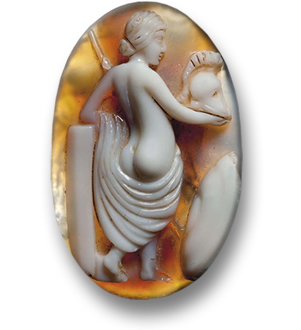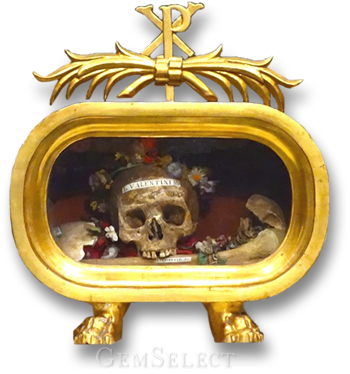|
|
Your Details
|
|
Your Details
|
Reviewed By Andreas Zabczyk
St. Valentine of Rome and Ancient Roman Romance Ancient Roman Agate Cameo of Venus - Goddess of Love
The legend of St. Valentine of Rome dates back to Emperor Claudius II, who ruled from 268 to 270 AD. Emperor Claudius II, known as "Claudius the Cruel," supposedly banned marriages to ensure young men would join his army. While some believe this ban applied to all marriages, it might have targeted Christian unions due to the persecution of Christians at the time. St. Valentine of Rome, the patron saint of lovers, was martyred, possibly for his faith or for assisting Christian couples in marrying. He was stoned and beheaded, and his skull was later adorned with flowers and enshrined in a golden reliquary at the Basilica of Santa Maria in Cosmedin, Rome.  The Skull of St. Valentine of Rome in a Golden Reliquary
How did the ancient Romans express their love during St. Valentine of Rome's time? Let's take a look at how love and marriages have changed since those times. Back in ancient Roman times, the minimum age for marriage was just 14 for boys and 12 for girls, and marriages were often arranged while children were still in infancy. Much like today, an ancient Roman wedding involved two willing partners, a contract, a ceremony at an altar, and an engagement ring. The deal was sealed with either a dowry paid by the bride's family that may have included land, jewelry, clothing, and other property. In the event of a divorce, the dowry would be returned. Ancient Roman jewelry during the time of Saint Valentine of Rome would have consisted of gemstone cameos, beautiful gold filigree work, and gemstone inlays. It is said that the engagement ring was introduced by the ancient Greeks or Romans. Though unlike modern engagement rings, the ancient Romans wore unembellished iron bands. The elite would have owned gold engagement rings that they could show off in public. Sumptuary laws did not allow the lower classes to wear gold, though some had their rings gold plated. Iron was a symbol of strength and the circular shape of the ring represented eternity - perhaps the iron ring as a symbol of a marital contract is where the word "ironclad" came from. It is also said that some ancient Roman brides had an everyday iron ring and a gold ring just for show. There were beliefs that magnetized rings were beneficial and protective, so some wedding rings were magnetized or contained lodestone; a natural magnet. While modern engagement and wedding rings are given as symbols of love, the Roman rings more likely indicated ownership. Roman men did not wear wedding rings, in fact, rings were not exchanged at all during the marriage ceremony, so the engagement ring was also the wedding ring. The marriage itself was sealed with a kiss, just as it is nowadays. Ancient Roman Ring with Clasped HandsAn interesting aspect of ancient Roman marriage was that gifts presented between spouses were considered the property of the giver upon separation or divorce. Thus, jewelry could have been returned to an ex. As Roman wealth increased and artistry developed, engagement and wedding rings became more elaborate with engravings, intaglios, cameos, and carved clasped hands. The ancient Roman bride wore braided hair, a special yellow veil, and a robe that was belted with a Hercules knot. Insults were hurled at the happy couple for good luck, and attendants carried the bride over the threshold of her new home, into her new married life. As you can see, while some customs of love and romance have changed, others remain the same as during ancient times. After all, love itself is timeless, as well as the gemstone jewelry that wear to celebrate it. We at GemSelect, hope you enjoyed reading this article, and whether you're single, married, or something in between, we wish you a very happy Valentine's Day for 2024! |
